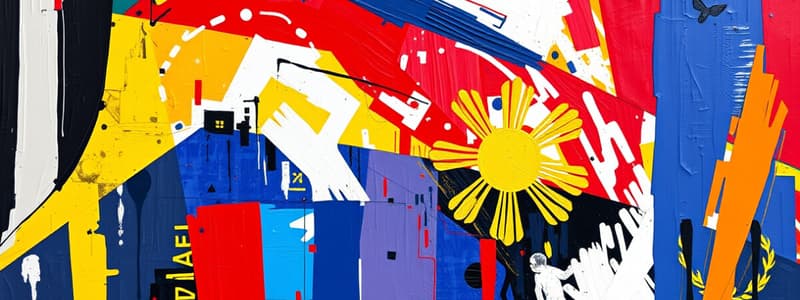Podcast
Questions and Answers
Which component is NOT part of national identity?
Which component is NOT part of national identity?
- Common values and beliefs
- Individual career achievements (correct)
- Shared culture and language
- Collective historical experiences
What does the blue color of the Philippine flag symbolize?
What does the blue color of the Philippine flag symbolize?
- Unity and harmony
- Valor and bravery
- Peace, truth, and justice (correct)
- Courage and sacrifice
What is a requirement when displaying the Philippine national flag?
What is a requirement when displaying the Philippine national flag?
- It should be displayed at sunrise and lowered at sunset (correct)
- It must be raised at midday
- It can be displayed without any specific protocol
- It can be displayed on the ground for decoration
What is emphasized by engaging in civic duties like voting?
What is emphasized by engaging in civic duties like voting?
Which statement about 'Lupang Hinirang' is correct?
Which statement about 'Lupang Hinirang' is correct?
During the performance of the national anthem, what is expected from citizens?
During the performance of the national anthem, what is expected from citizens?
What does the protocol surrounding the anthem emphasize?
What does the protocol surrounding the anthem emphasize?
How does a sense of national identity affect citizens?
How does a sense of national identity affect citizens?
Flag Days in the Philippines are celebrated from which dates?
Flag Days in the Philippines are celebrated from which dates?
What is NOT a common expression of national identity?
What is NOT a common expression of national identity?
Flashcards are hidden until you start studying
Study Notes
Patriotism and Loyalty
National Identity
- Definition: National identity refers to a person's sense of belonging to a nation and the characteristics that define that nation.
- Components:
- Shared culture, language, and history.
- Common values and beliefs that unite citizens.
- Importance:
- Fosters a sense of community and belonging among citizens.
- Promotes national pride and collective responsibility.
- Expressions:
- Participation in national events and celebrations.
- Engagement in civic duties like voting and community service.
Respect for the Philippine National Flag
- Symbolism: The flag represents the nation’s sovereignty, history, and unity.
- Colors:
- Blue: Peace, truth, and justice.
- Red: Patriotism and valor.
- White: Purity and peace.
- Protocol:
- The flag should be displayed prominently and respectfully.
- It must be raised at sunrise and lowered at sunset.
- Must not touch the ground or be used for decoration.
- Flag Days: Celebrated from May 28 to June 12, promoting awareness of the flag’s significance.
Respect for the Philippine National Anthem
- Title: "Lupang Hinirang"
- Significance: The anthem reflects the aspirations, struggles, and hopes of the Filipino people.
- Protocol:
- Must be sung with the proper tempo and respect.
- Standing at attention is required during the anthem’s performance.
- The anthem should not be altered or sung inappropriately.
- Civic Importance: Singing the anthem reinforces national pride and collective identity among citizens.
National Identity
- National identity encompasses an individual's belonging to a nation, highlighting distinct characteristics that define it.
- Key components include a shared culture, language, history, and common values that unify citizens.
- Fostering national identity enhances community sense and belonging, while cultivating national pride and collective responsibility.
- Expressions of national identity can be seen in national events, celebrations, civic duties like voting, and community service participation.
Respect for the Philippine National Flag
- The Philippine flag symbolizes the nation's sovereignty, rich history, and unity among its citizens.
- Color meanings:
- Blue signifies peace, truth, and justice.
- Red embodies patriotism and valor.
- White represents purity and peace.
- Protocols for flag display include:
- Flag must be prominently displayed and treated with respect.
- It should be raised at sunrise, lowered at sunset, and must not touch the ground.
- The flag cannot be used as a decoration or for advertisement purposes.
- Flag Days, observed from May 28 to June 12, promote awareness about the flag's significance in national identity.
Respect for the Philippine National Anthem
- The national anthem, titled "Lupang Hinirang," captures the aspirations, struggles, and hopes of the Filipino people.
- Proper performance protocols include:
- Singing the anthem at the correct tempo, with full respect and attention.
- Standing at attention during the anthem is mandatory.
- Alterations or inappropriate renditions of the anthem are not permissible.
- The national anthem plays a critical role in reinforcing national pride and collective identity among Filipinos.
Studying That Suits You
Use AI to generate personalized quizzes and flashcards to suit your learning preferences.




